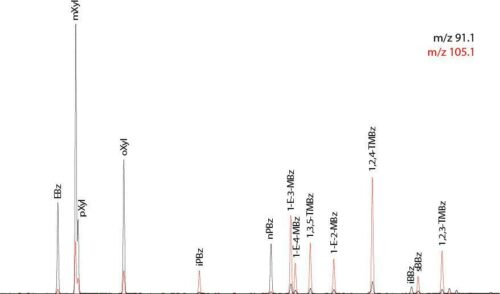Alkylbenzenes
Applications
The C2 and C3 alkylbenzenes in extracted bitumen are particularly useful for investigating reservoir continuity because they are very sensitive to alteration processes. GC-MS analysis (low or high resolution) with selected ion recording (SIR) can be used on aromatic fractions or total extract.
Where evaporative loss has affected these light components, longer chain alkylbenzenes can be analysed by a similar method. Where they have been affected by biodegradation, alkylnaphthalenes can be considered instead.
Sample requirements
Core plugs are best, but cuttings can be used. Plugging should be performed using additive-free water. Organic based lubricants must be avoided, as should proximity to other plugs sites (e.g. for poroperm determination) and the periphery of cores and areas containing fractures.
A minimum of 5 g of core is required for the analysis.
It is also a good idea to analyse a mud cake sample from each well to check the implications of possible contamination of the plug samples by mud and any entrained hydrocarbons from previous use.
Analytical procedure

Standard solvent extraction of reservoir rocks is required. The GC-MS analysis to determine alkylbenzene distributions can be performed on whole extract or an isolated aromatics fraction, depending upon mode of operation of the MS.
For low resolution instruments (i.e. quadrupole) it may be helpful to isolate an aromatics fraction to reduce interference from other compounds. Even for high resolution MS, chromatographic quality, and hence quantification accuracy, may benefit from isolation of an aromatics fraction. However, evaporative losses of the most volatile components is a consideration when isolating aromatics.
A Thermo Scientific TSQ Quantum XLS instrument is used to analyse alkylbenzenes in whole oils/extracts after 1:10 dilution in hexane (1:46 split injection). The instrument is tuned to a resolution of 0.4 mass units and data is acquired in SIR mode. The GC is fitted with a 60 m x 0.25 mm i.d. CP-Sil-5 CB-MS column (0.25 mm film thickness. The temperature programme is 35°C (4 min.) to 91°C at 1°C/min., and then to 320°C (25 min.) at 15°C/min. Distributions can be obtained from the fragment ions m/z 91.1 and 105.1.
The C1–C4 substituent (toluene to tetramethyl) range can be analysed by molecular ions (m/z 92.0626, 106.0783, 120.0939 and 134.1096) together with fragment ions (91.0548 and 105.0704) using HR-GC-MS analysis.
A Micromass ProSpec high resolution instrument is used, tuned to a resolution of 500 and data is acquired in full scan mode (m/z 75–300). The column is a 60 m x 0.25 mm CP-Sil-5 CB-MS (film thickness 0.25 mm). The temperature programme is 35°C (6 min.) to 60°C at 1.5°C/min and then to 320°C (20 min.) at 3°C/min.
D8-naphthalene and D10-phenanthrene are used as internal standards when quantitative results are required.
Potential problems
- Absence/very low abundance of akylbenzenes due to severe biodegradation
- insufficient sample
- interference from hydrocarbons in mud
References
Fox R.J., Bowman M.B.J. (2010) The challenges and impact of compartmentalization in reservoir appraisal and development. In (ed. Jolly S.J., Fisher Q.J., Ainsworth R.B., Vrolijk P.J., Delisle S.) Reservoir Compartmentalization. Special Publications 347, 9–23. Geological Society, London.